MOTAT's iconic Lancaster

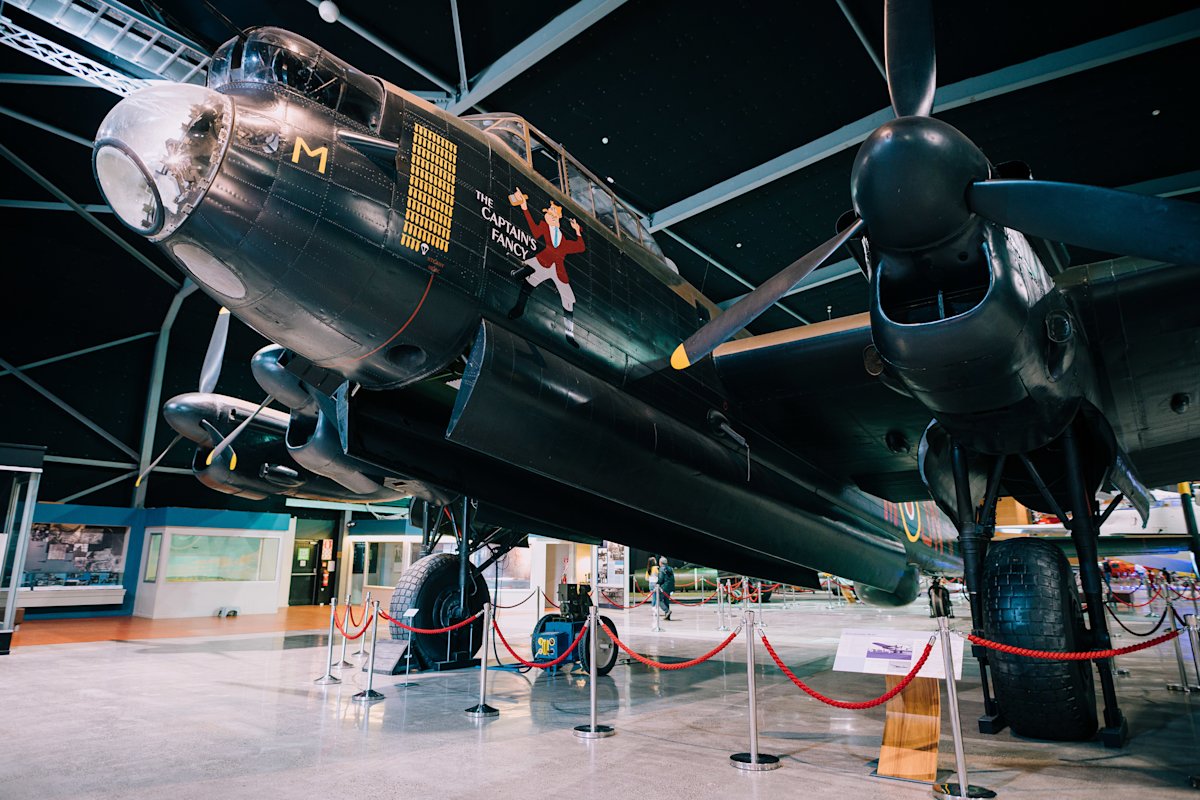
A long and distinguished history
The Avro Lancaster is a British four-engine heavy bomber designed by Roy Chadwick during the Second World War to replace the Avro Manchester. The first prototype flew in January 1941, and production began in the middle of that year. The first production Lancaster flew in October 1941, and subsequently, the first squadron to use the new aircraft – 44 (Rhodesia) Squadron of No. 5 Group of Bomber Command – was established. 44 Squadron flew its first operation using Lancasters on 3 March 1942, followed a week later by its first bombing mission.
The majority of the aircraft built during the war years were manufactured by A.V. Roe and Company (Avro) at their factory at Chadderton near Oldham, Lancashire. They were then assembled and test flown from Woodford Aerodrome in Cheshire. Others were built by Metropolitan-Vickers and Armstrong Whitworth, and a number were also produced at the Austin Motor Company works in Longbridge, Birmingham. In later years some were also produced at Chester and Castle Bromwich (both Vickers-Armstrong factories). 7377 were built in total.
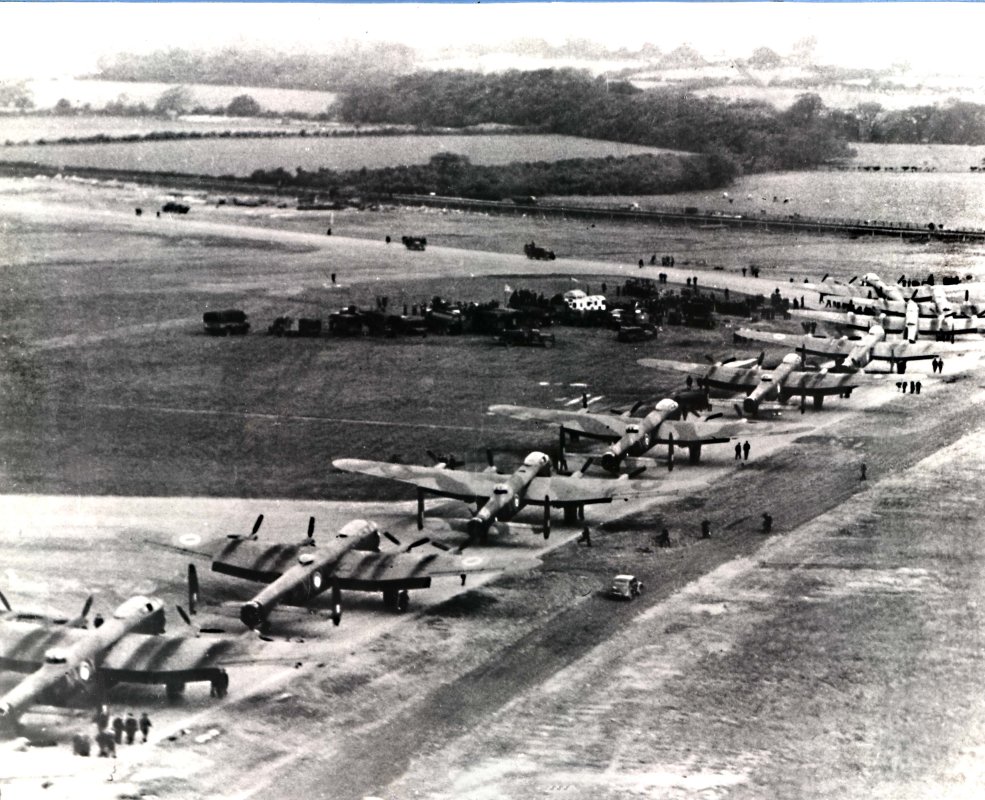
A group of nine Avro Lancaster bombers taxiing down a runway during WWII, Walsh Memorial Library, The Museum of Transport and Technology (MOTAT). 04-3304
A long-range role
The Lancaster is a mid-wing cantilever monoplane with an all-metal fuselage powered by four Rolls Royce Merlin water-cooled piston engines driving de Havilland Hydromatic three-bladed airscrews (propellers). The wings were constructed in five main sections as was the fuselage. All main sections were built separately and were fitted with all the required equipment before final assembly. The aircraft has retractable main landing gear with a fixed tail-wheel. Their main disadvantage – which had a major impact on the lives of the crew if an aircraft was shot down – was that there were only two formal parachute exits. One was in the floor of the bomb aimer’s compartment in the nose but was far from most of the aircrew; the second was the main fuselage door which carried the warning that it should only be used in ‘extreme emergency’ as anyone leaving that way was highly likely to strike the aircraft’s tail.
The other hatches provided in the roof were very small. As a result, only ten percent of Lancaster aircrew survived the destruction of their aircraft. Postwar, the Lancaster was supplanted as the main strategic bomber of the Royal Air Force (RAF) by the Avro Lincoln, a larger version of the Lancaster. Instead, the Lancaster took on the role of long-range anti-submarine patrol aircraft (later supplanted by the Avro Shackleton) and air-sea rescue. It
was also used for photo-reconnaissance and aerial mapping, as a flying tanker for aerial refuelling and, as the Avro Lancastrian, a long-range, high-speed, transatlantic passenger and postal delivery airliner.
The war in the Pacific
The Lancaster at MOTAT, NX665, was built in 1945. It is a B.VII, the final production version built by Austin at their Longbridge factory near Birmingham. The main difference between the Mk VII and earlier versions was the use of a Martin turret instead of the earlier Fraser Nash FN50 mid-upper turret. The Martin turret, built by the Glenn L. Martin Company in the United States, carried two 0.5-inch Browning Mk II machine guns. In the Mark VII the position of the turret was moved forward to above the bomb bay.
The Mk VII version arrived too late for the war in Europe. They were then modified to the B.VII (FE) standard, for use in the Far East in the war against Japan. Japan’s surrender after atomic bombs were used on Hiroshima and Nagasaki meant that these aircraft were not required, so NX665 was stored at RAF 38 Maintenance Unit, and in 1951 was sold to the French Government to support the Western Union (the fledgling NATO).
Fifty-nine Lancaster B.I and B.VII aircraft were overhauled by Avro to RAF maritime reconnaissance standards and delivered to the French Navy’s Fleet Air Arm (Force maritime de l'aéronautique navale) between 1952-3. NX665 operated from Morocco, Vietnam and New Caledonia, flying for the French Navy as WU-13. (The ‘WU’ refers to Western Union – see above.) It served with 24F, 10F and 10S French Fleet Air Arm squadrons. It and two other Lancasters arrived in New Caledonia between August and September 1957, and served in Squadron 9S based at Tontouta airfield, near Nouméa.
There, it carried out air-sea rescue, surveillance flights and other duties around the South Pacific. NX667 was donated to MOTAT by the French government after enquiries made by one of MOTAT’s foundation members, Mervyn Sterling. The French Fleet Air Arm were replacing the old Lancasters with Douglas C-54 Skymaster aircraft, and Sterling hoped that one could be donated to MOTAT. It flew to Auckland on 15 April 1964 accompanied by WU-15 (NX611) which then ferried the French crew back to New Caledonia. At the official ceremony, WU-13/NX665 was presented to the people of New Zealand by Alain Sice, then the French Chargé d'Affaires, as a gesture of goodwill, friendship and comradeship. Sir John Allum, former mayor of Auckland and patron of MOTAT, accepted the aircraft. Its final flight was over Northland on 16 April and it came to MOTAT with 2348.3 hours in its log.
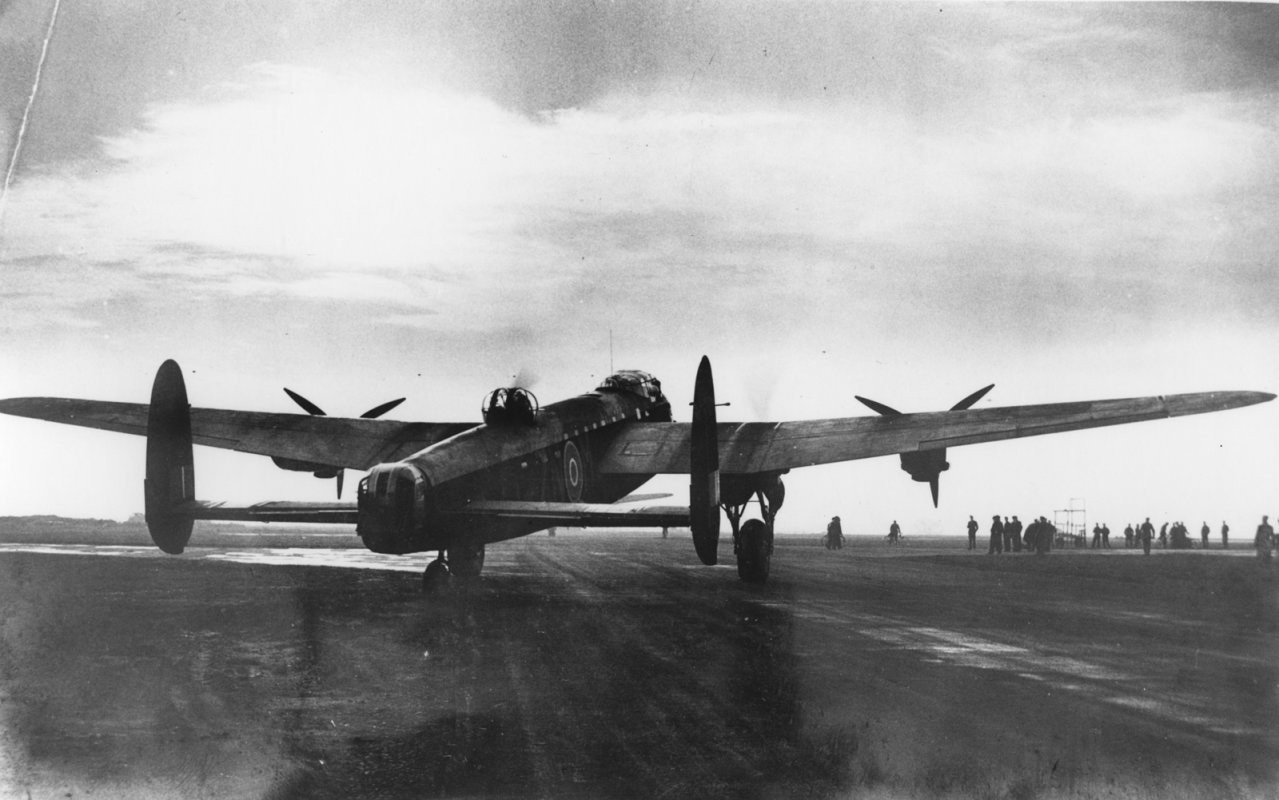
The Avro Lancaster on the runway at Whenuapai in 1964, Walsh Memorial Library, The Museum of Transport and Technology (MOTAT). 02-1002
The Lancaster arrives at MOTAT
After the aircraft arrived in Auckland, the Royal New Zealand Air Force (RNZAF) took over and
dismantled it, removing the wings and engines to enable George Dale Transport to shift it to
MOTAT’s Western Springs site on 24 May 1964. The wings and engines were re-attached, again under the RNZAF supervision, in June 1964. It was on display outside at the Western Springs site – providing a surprise for unwary passers-by, especially when the engines were started – until it was moved to the Sir Keith Park Memorial Airfield (now MOTAT 2) in Meola Road on 9 June 1976.
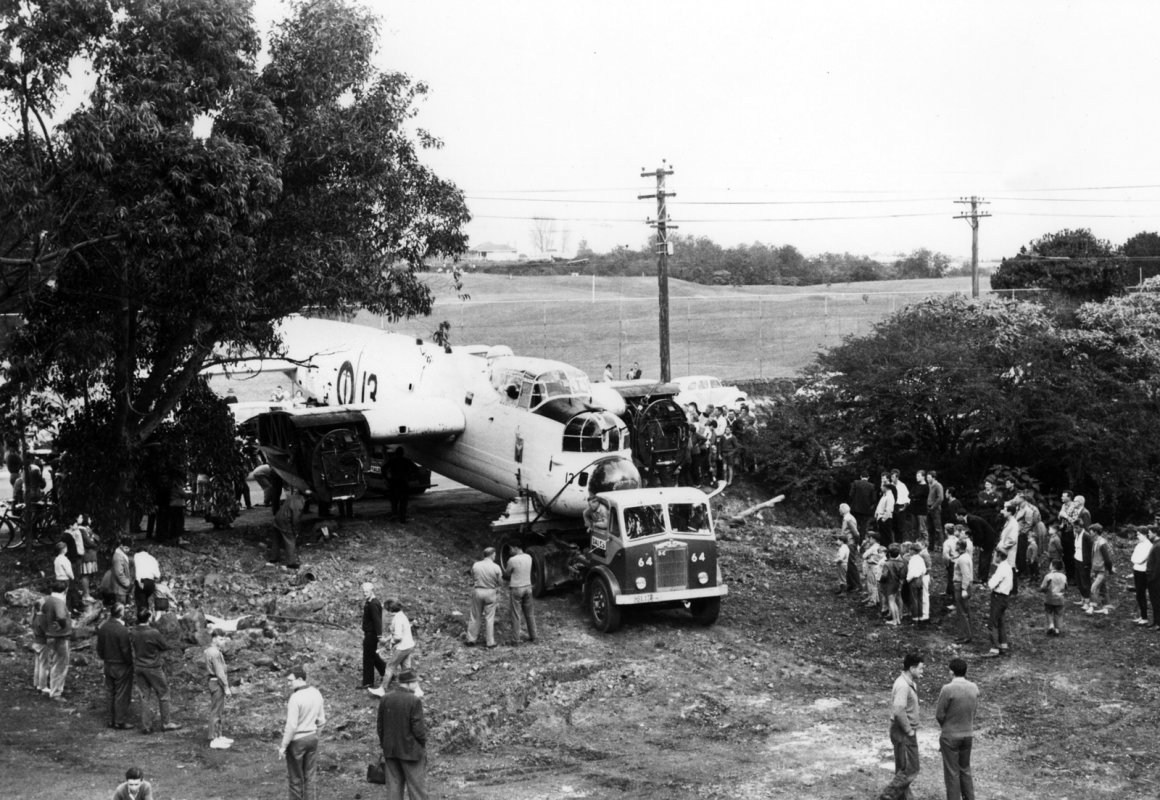
The Avro Lancaster arrives at MOTAT on 4 May, 1964, Walsh Memorial Library, The Museum of Transport and Technology (MOTAT). 02-1044
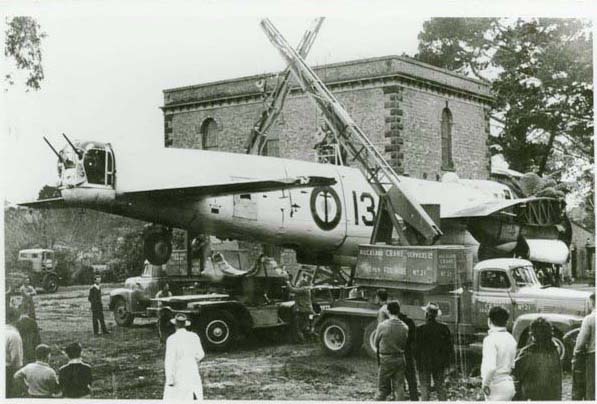
Two cranes lifting the Avro Lancaster off a transporter at MOTAT in 1964, Walsh Memorial Library, The Museum of Transport and Technology (MOTAT). 02-1046
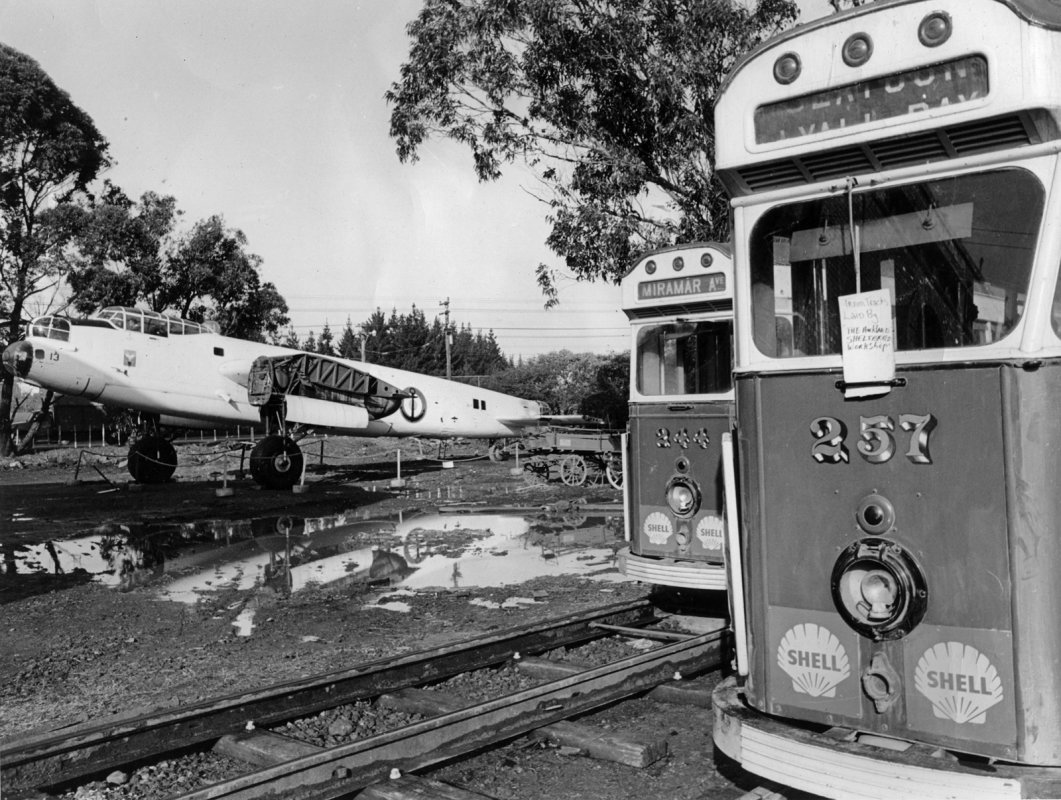
The Avro Lancaster on display at MOTAT still without wings in 1964, Walsh Memorial Library, The Museum of Transport and Technology (MOTAT). 04-4276
Gun turrets
In May 1969, thanks to the Royal Canadian Air Force, a Lancaster Fraser Nash FN50 mid-upper gun turret was presented to MOTAT by the Canadian High Commissioner to New Zealand, R.M. MacDonnell. The museum has two more of these turrets – one from Sydney and another courtesy of the Fuerza Aeréa Argentina (Argentine Air Force).
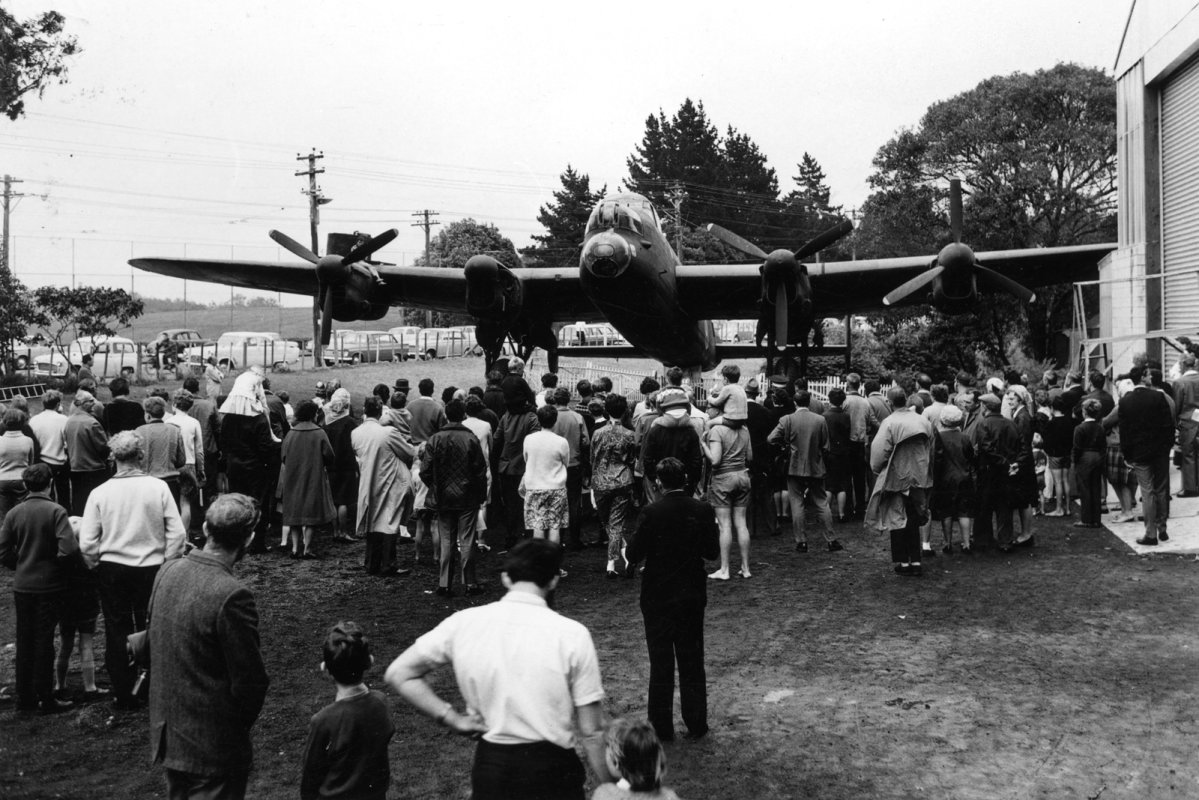
Outdoor display, 1974, Walsh Memorial Library, The Museum of Transport and Technology (MOTAT) 02-951
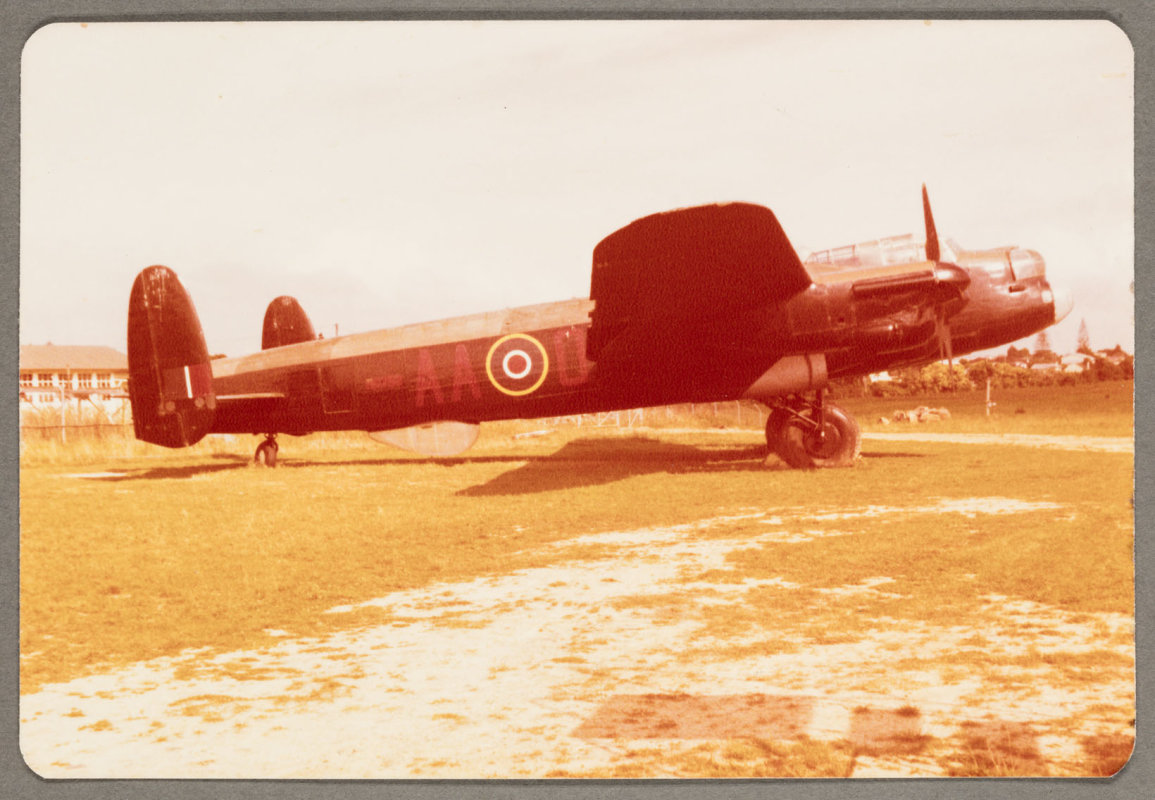
The Avro Lancaster at Meola Rd, January 1980. Photo by John Page, Walsh Memorial Library, The Museum of Transport and Technology (MOTAT). PHO-2018-5.1.539
After its move to MOTAT’s Meola Road site, the aircraft was restored by members of the Bomber Command Association (NZ) to recreate the appearance of a Lancaster Mark III of Bomber Command used in September 1944. This decision to modify the Mark VII NX665 was made because the aircraft had been given to MOTAT ‘in memory of the many New Zealander crews who took part in the liberation of France in this type of aircraft.’ A condition of fitting the Fraser Nash turret was that the process was fully documented and photographed in case the decision was reversed in the future. All the material removed during the modification has been retained.
c.1971. [Auckland Centennial parade and MOTAT Live Days], WAV-2021-10. Walsh Memorial Library, The Museum of Transport and Technology (MOTAT).
When WU-13 arrived at MOTAT, it was in the white livery of French Fleet air Arm Squadron 9S. After its restoration it was painted in 1944 Bomber Command scheme, with the starboard side painted as ND752/AA-O of 75 Squadron, and the port side as PB457/SP-V of 101 Squadron. Both of these aircraft were lost over Germany and their markings were chosen not because they are associated with famous aircraft or crews, but as representative of the thousands of the Lancaster bombers which flew in Bomber Command. It has since been repainted as NE181/JN-M, 'The Captain's Fancy' referring to an aircraft which served with 75 (NZ) Squadron and completed over 100 bombing missions in Europe during the Second World War.
From 1942 onwards, the Lancaster became the mainstay of the RAF’s heavy bomber fleet. Once operational, Lancasters flew on 156,192 sorties (148.403 of these were bombing raids), and dropped 608,612 tonnes of bombs. By the end of the war in Europe (May 1945), there were over 50 squadrons equipped with these aircraft, the majority of these being the Lancaster B I model. The Lancaster operated in almost every major bombing raid of the European conflict, for example, the (in)famous Thousand Bomber Raids to Germany in 1942, and the aircraft was modified to carry the ‘Bouncing Bomb’ in Operation Chastise, the ‘Dambusters’ raid on the attack on the Möhne, Eder and Sorpe dams in Germany’s Ruhr Valley in 1943.
As well as Operation Chastise, the aircraft were used in operations on 25 April 1945 bombing German Chancellor, Adolf Hitler’s mountain retreat and the associated SS barracks at Berchtesgaden, and also in repatriating British ex -prisoners of war (Operation Exodus) and dropping food and other supplies to the starving Dutch (Operation Manna). The aircraft has been called ‘the most effective heavy bomber of the Second World War in Europe’.
As presented at MOTAT, NX665 reflects the role of New Zealand air crew – and ground crew – in the war in Europe between 1939-1945. Its work for the French Force maritime de l'aéronautique navale is acknowledged in the photographs accompanying the object label in the current display. The role the aircraft played on search and rescue missions in the Pacific Ocean is significant, and is a connection to one of the important current activities of the Royal New Zealand Air Force around New Zealand and in the Pacific.
A rare example
NX665 is also significant for its rarity. There are only 17 examples of the Avro Lancaster in existence, only 4 of which actually flew in operational sorties during the Second World War. Like MOTAT’s NX665, most are on static display, although in 2019 a couple are still operational, and a couple more are undergoing restoration to make them airworthy again. As a result of its modifications (the addition of the Fraser Nash turret, and the way it is painted), and combined with the Bomber Command exhibition close by, NX665 enables visitors to MOTAT to learn about the activities of those New Zealand air and ground crew who worked on and flew in Avro Lancaster aircraft during the Second World War.
No. 75 (NZ) Squadron played an important role in support of RAF operations during the Second World War. On 4 April 1940, the New Zealand Squadron was renamed No. 75 Squadron with the letters ‘NZ’ added in brackets after the number. This was the first British Commonwealth squadron to be so created. The squadron saw action over countries including France, Norway, Belgium and Germany. Although often referred to as a Royal New Zealand Air Force (RNZAF) unit, 75 Squadron was equipped and controlled by the RAF until the end of the war (August 1945). MOTAT's collection includes Medals awarded to Squadron Leader, John Lesley Munro (Les), 617 Squadron.
In October 1946, in gratitude for the work done and sacrifices made by its New Zealand air crew, Britain transferred the squadron number, badge and colours to the RNZAF. No. 2 Squadron RNZAF was disposing of its Lockheed Ventura bombers at the time, and so was disbanded and renumbered as No. 75 Squadron RNZAF. The RAF has never again had a No. 75 Squadron, and 75 is the only RAF Squadron to be given to a Commonwealth country by Britain.
At the outbreak of the Second World War, No. 101 Squadron had just been reequipped with the Bristol Blenheim IV aircraft. It flew its first Blenheim operation on 4 July 1940, then, in April 1941 began to transfer to the Vickers Wellington. It converted to the Avro Lancaster I
and III the following year. From October 1943 the squadron began to use ABC jamming equipment. ABC, or Airborne Cigar was a system designed to jam the radio frequencies used by the Germans to transmit a running commentary on the night's events to their fighter aircraft. When equipped with the ABC equipment,101 Squadron Lancasters carried an eighth, German-speaking crew member, whose role was to listen in to the German radio transmissions and decide which ones to jam. The squadron suffered heavy casualties as German fighter aircraft could detect the jamming transmissions – 145 Lancasters were lost on operations.
At the end of the war 101 Squadron was one of the Lancaster squadrons used in Operation Manna, dropping much needed food into Holland.
Avro Lancaster
Crew: 7: pilot, flight engineer, navigator, bomb aimer/nose gunner, wireless operator, mid-upper and rear gunners
Length: 69 feet 4 inches (21.11 m)
Wingspan: 102 feet 0 inches (31.09 m)
Height: 20 feet 6 inches (6.25 m)
Wing area: 1,297 square feet (120.5 m²)
Engines: 4 × Rolls-Royce Merlin XX liquid-cooled V12 engines
Armament Guns: Two 0.303 inch (7.62 mm) Browning Mark II machine guns in nose turret, two 0.303 inch Browning Mark II machine guns in upper turret, and four 0.303 inch Browning Mark II machine guns in the rear turret.
Bombs: Maximum normal bomb load of 14,000 lb (6,400 kg) of bombs
Useful sources
M.D. [Mervyn] Sterling and J.B. [Jim] Duncan, Lancaster NX665, Auckland, 1992
Philip J.R. Moyes, Royal Air Force Bombers of World War Two, Volume One, Chalfont St Giles,
England, 1968
Article by Megan Hutching, September 2023
